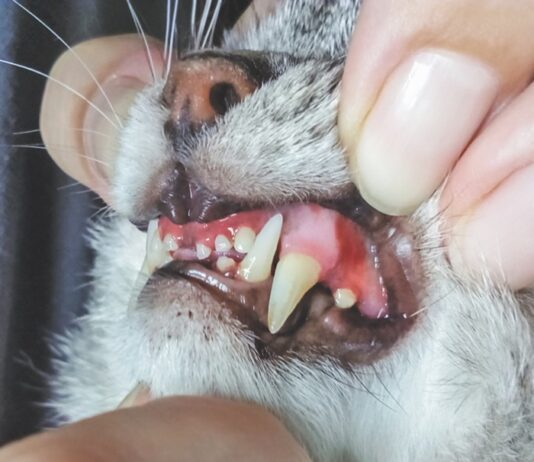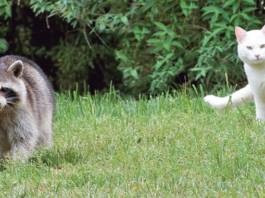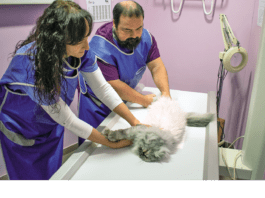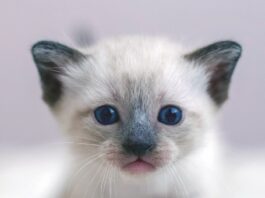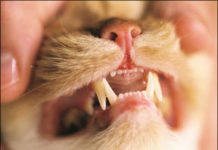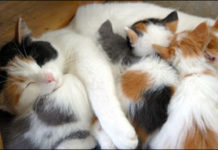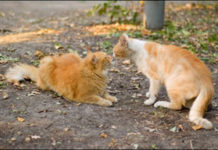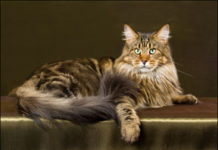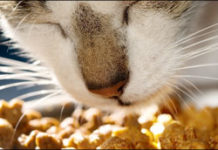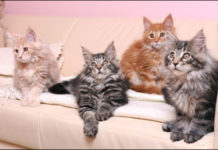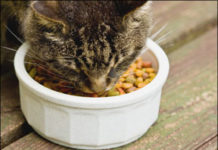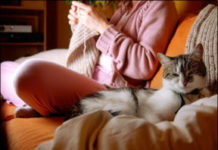Diagnosis: Feline Anemia
Veterinarians generally recommend that all cats undergo a thorough physical examination at least once a year until they have reached seven or eight years of age, and twice annually thereafter as they progress into their senior years. The exam should include a complete blood count (CBC), a procedure that can reveal or at least suggest the presence of many feline health disorders. The importance of the CBC should not be underestimated. Among other things, a CBC will determine the concentration of red blood cells (erythrocytes) in a drop or two of blood. The procedure will also reveal the density of hemoglobin, an important constituent of each erythrocyte.
Feline Upper Respiratory Infections
Your seven-year-old cat is a generally healthy animal. Except for a fleeting bout of gastrointestinal upset a few years ago, shes never had a really serious sick-day in her life. But your neighbors cat always seems to be ill. Every couple of months, she shows up on your doorstep wheezing and sneezing. Her eyes are red and watery, and she acts lethargic. These disturbing signs persist for a week or so, but then she seems to be okay again for a while. Its quite likely that the cat next door is suffering from an upper respiratory infection, a highly contagious disease affecting her nose, sinuses, pharynx and larynx the structures that filter, heat and dehumidify inhaled air before it flows to her lungs. Why is it, you wonder, that your cat never experiences this problem, while the cat next door cant shake it?
Chronic Respiratory Disease in Cats
Chronic rhinosinusitis (CRS) is a common disease in cats with an unclear cause. A number of studies have indicated that most cases of upper respiratory disease in the cat are complicated by secondary bacterial infections. Antibiotic therapy is frequently employed to treat feline CRS. A study published in the Journal of Feline Medicine & Surgery evaluated the effect of sampling method on culture results in 44 cats.
Abscesses: Take Them Seriously
For several days, your cat has been acting uncharacteristically lethargic and off his food. Then one evening, while stroking his back, you feel a smallish lump just to the side of his tail. Although you touch the lump gently, he responds with a hiss, leaping from your lap and scurrying into a dark corner. The lump you discovered is quite possibly an abscess, and the sensitive swelling may indicate that the cat has an infection - and necessitating prompt veterinary care. Distinctive Characteristics. An abscess is a localized collection of pus, a yellowish fluid that forms at the site of an infection. Although pus typically contains a certain amount of cellular debris and dead tissue, it is composed mainly of white blood cells that have been summoned by the immune system to combat invading bacteria or other microorganisms. Cats can develop a variety of lumps and bumps on their skin - cysts, tumors, pimples and so forth - but abscesses have their own distinctive characteristics, notes William Miller, VMD, medical director at Cornell Universitys Companion Animal Hospital. "Because an abscess is filled with pus," he says, "it will be inflamed, warm and tender. Tumors are not usually like that, and pimples are merely superficial eruptions, affecting the outer layer of skin and minuscule by comparison to an abscess." External and Internal. An abscess may develop at the site of a penetrating wound - if a cat steps on a thorn, a wood sliver or a piece of glass, for example. But abscess-producing infections in cats usually result from bites from other cats, since the bacteria that cause infection are normal inhabitants of the feline mouth.
Keep a Feline Health Diary
If your cat kept a diary, it might read something like this: Yesterday, I slept, ate, slept some more, chased a paper ball, napped, ate again and napped. While that may describe a cats typical day, it wont necessarily help you or your veterinarian if your cat develops a health or behavior problem. "Keeping a diary for your cat is a good idea in general, but particularly when your cat is ill," says Drew Weigner, DVM, who is board-certified by the American Board of Veterinary Practitioners. Keep Track of the Basics. At a minimum, you should track your cats veterinary visits, vaccinations, flea treatments and any medications your cat takes. Beyond that, record anything that is unusual for your particular pet. For example, if you change your cats diet, note the date and track changes (such as vomiting or diarrhea). Or, if your cat urinates more or less often than usual, record that in the diary. "If there is anything unusual, or if you start seeing something more often, you should take a trip to the veterinarian," says Dr. Weigner, whose practice is The Cat Doctor in Atlanta, Georgia. If your cat exhibits any changes in behavior, you should note anything unusual thats happened in the house, such as human visitors or changes in the environment. Are strange cats hanging around outside? "Anything can act as a trigger," says Dr. Weigner. "Keeping a journal helps separate the subjective from whats objective. If you keep a log of it, you know for sure."
Diagnosis: Heart Disease
Although one cat may be prettier, smarter or more athletic than another, nature plays no favorites when it comes to doling out heart disease. All cats are at potential risk for serious insult to this vital organ. In some cases, the signs are obvious to the trained eye. In others, a serious heart disorder can remain hidden for years before finally expressing itself in a sudden, perhaps fatal, deterioration of function. The best thing that owners can do is to make sure their cats have thorough medical checkups - at least once a year - during which the veterinarian pays close attention to the heart. While examination with a stethoscope cannot detect all feline heart diseases, its probably the most cost-effective approach to diagnosis in otherwise healthy cats. Congenital Defects. Most feline heart disorders are acquired during the course of an animals life, but others are present at birth. However, says John Bonagura, DVM, a professor of veterinary clinical sciences at the Ohio State University Veterinary Hospital, congenital feline cardiac disease is relatively rare, occurring only in an estimated one or two percent of kittens. The most common congenital disorders, he notes, are heart valve malformations and holes in the septa. Abnormal valve development most often involves the mitral valve, located between the left atrium and the left ventricle. While a number of structural problems can occur, the end result is typically a valve that cannot close properly and thus allows blood to leak backwards into the atrium. Holes in the septa most frequently affect the membrane partitioning the right and left ventricles and may also cause the inappropriate flow of blood between the heart chambers.
Why Is Your Cat Coughing?
A wide variety of irritants from minor and transient to severe and indicative of a major health problem can affect any portion of the feline respiratory system, whose purpose is to warm and humidify inhaled air, deliver oxygen to the lungs, and expel carbon dioxide and other waste gases. A complex pathway of tracts and organs, the upper respiratory system consists of the nose; two nasal passages; the nasal cavity (a hollow structure surrounded by air-filled spaces that are situated just above and below the eyes); and the pharynx (a cavity behind the mouth) that opens, via a passageway called the larynx; to a tubular structure, the trachea, a flexible tube commonly referred to as the windpipe.
Short Takes: 09/09
Governor Linda Lingle, accompanied by State Civil Defense Director, Major General Robert Lee, highlighted the importance of emergency preparedness by showcasing Hawaiis ongoing emergency shelter programs for people with special health needs and pet-friendly shelters. State Civil Defense, working with the State Department of Education, county civil defense agencies, American Red Cross, Department of Health, Hawaiian Humane Society and other public and private sector partners, has designated 158 facilities statewide that may serve as Special Health Needs shelters, and another 55 facilities that may be used as Pet-Friendly shelters. These shelters are located in separate rooms or buildings on public school campuses where general population emergency shelters are also located.
Short Takes: 08/09
Baycom Diagnostics, Inc. has developed a cost effective diagnostic kit for monitoring and testing feline and canine diabetes. Currently, veterinarians use hand held glucose meters to test cats and dogs for the potential of diabetes. These meters are a critical part of human diabetes management, yet often do not work well with small animals, are expensive and must be used several times a day. The companys president says veterinarians could administer Baycoms product in a simple, easy test once every 90 days to get an accurate measurement.
Feline Digestive Disorders
Digestive system disorders in general are among the most frequently observed health problems in cats. While many of these disorders are primarily associated with organs such as the liver, pancreas and gall bladder - all of which play a crucial role in the digestive process - plenty of them are centered in the alimentary canal, the long tube leading from a cats mouth to its anus. Most Common. By far the most prevalent feline digestive tract disorder, says Dr. Bartges, is inflammatory bowel disease (IBD). The condition, characteristically evidenced by chronic vomiting and diarrhea, is widely thought to be the consequence of several different disorders involving the feline immune system. The changes that are consistently found upon microscopic analysis in the lining (mucosa) of an affected cats intestines - a superabundance of immune system cells, for example - suggest that abnormal immune system activity may precipitate the disease.
Charges in Melamine Pet Food Recall
ChemNutra Inc., a Las Vegas-based ingredients broker, pleaded guilty on June 16 to federal charges of distributing tainted wheat gluten that led to the mass pet food recalls of 2007. The charges stem from a February 2008 indictment that alleged ChemNutra imported more than 800 metric tons of melamine-contaminated wheat gluten from China between November 2006, and February 2007, then sold the product to various pet food manufacturers.
Five Myths About Heartworm
One mosquito bite can infect a cat with heartworm, a potentially destructive and insidious disease, which reveals itself as H.A.R.D. (Heartworm Associated Respiratory Disease). The American Heartworm Society (AHS) and the American Association of Feline Practitioners (AAFP) have teamed up to get this urgent message out to cat owners through the KNOW Heartworms campaign (www.knowheartworms.org). Experts now feel that heartworm prevention in cats is extremely important because the dangers of heartworm disease are much more significant that previously believed. Here are five common myths about heartworm disease that can put your pet at serious risk.

